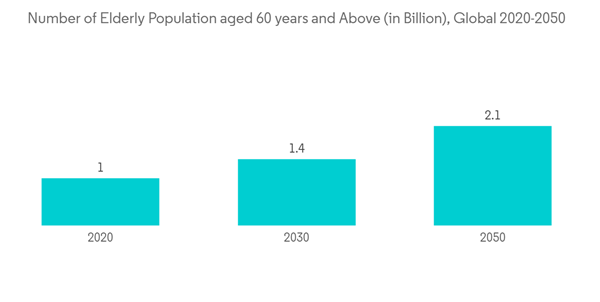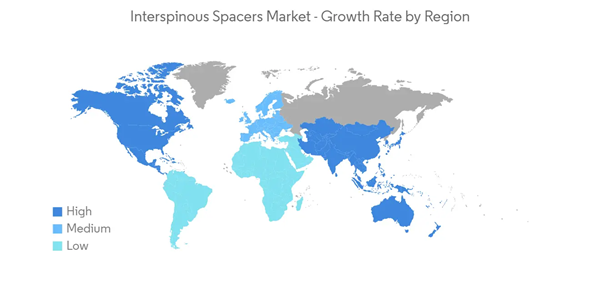The COVID-19 pandemic has had an adverse impact on the Interspinous Spacers market initially. The sudden outbreak of the contagious viral infection and the absence of any medication or vaccine led to a lockdown globally. The non-COVID treatment, such as surgical interventions and non-urgent medical treatment, was temporarily postponed or canceled. Also, the risk of the virus reduced the number of patients visiting the hospital for non-COVID issues. The interspinous spacers are used in spinal surgeries, which was also adversely impacted by the COVID-19 restrictions. According to a study published in the Journal of Orthopaedic Trauma in December 2021, there was a reduction of over 20% in acute spinal referrals from UK emergency departments during the COVID-19 lockdown initial phase. A study published in the Spine Journal in July 2021 stated that over one-third of elective spine, surgeries were canceled, as per their study, due to COVID-19.
However, in the post-pandemic with the lifting of the lockdown and the resumption of the non-COVID, non-urgent treatment, surgeries, and procedures, the interspinous space market is expected to regain its growth pace as it was in the pre-pandemic period. American Academy of Orthopaedic Surgeons in 2021 stated that the non-essential orthopedic surgeries which were postponed in the United States due to COVID-19 had been resumed across the country. Thus, the COVID-19 outbreak has adversely impacted the market's growth in its preliminary phase. Moreover, the market is expected to grow further at a stable pace with the resumption of elective spine surgeries and treatment, which would gradually increase the use of interspinous spacers globally.
Further, the interspinous spacer has a higher occurrence in the geriatric population. As the geriatric population is increasing globally, and there is an increasing demand for minimally invasive procedures for spinal stenosis that has helped in the growth of this market. According to the World Health Organization report (WHO) report in 2020, by 2030, 1 out of every six people on the planet will be 60 years old or older. The number of people aged 60 and up is expected to rise from 1 billion in 2020 to 1.4 billion by 2050. By 2050, the global population of people aged 60 and above will double to reach 2.1 billion. Between 2020 and 2050, the number of people aged 80 and above is expected to triple, reaching 426 million.
In addition, there are also increasing technological advancements seen in this field; therefore, the demand for interspinous spacers is increasing. However, compilations related to the interspinous spacer, especially in the older population, have been restraining the overall growth of the market. Therefore, owing to the aforementioned factors, the studied market is anticipated to witness growth over the analysis period. However, the complications associated with lumbar spinal fusion are likely to impede the market growth.
Interspinous Spacers Market Trends
Lumbar Spinal Stenosis Segment is Expected to Dominate the Market
Lumbar spinal stenosis is a narrowing of the spinal canal, compressing the nerves traveling through the lower back into the legs. While it may affect younger patients due to developmental causes, it is more often a degenerative condition that affects people who are typically aged 60 and older. The high prevalence and advancing technology of lumbar spinal stenosis and its management are boosting the growth of the segment. According to JAMA Patient Page, in May 2022, over 11% of elderly adults in the United States have the condition of Lumbar spinal stenosis. According to a study published in the Journal of Pain Research in April 2022, interspinous spacers are highly studied for clinical research and scientific studies for the management of lumbar spinal stenosis by reducing pain, improving mobility, and reduction in the use of opiates. The study has recommended the use of interspinous spacers for mild-to-moderate spinal lumbar stenosis.The players in the market have received approval for their advanced products for the management of lumbar spinal stenosis. For instance, in July 2022, Aurora Spine Corporation received FDA clearance for its ZIP family of MIS implants for the management of lumbar spinal stenosis. The ZIP implant spacer has no screw and is minimally invasive, which bears an edge over traditional surgeries and other interventional procedures.
Therefore, the lumbar spinal stenosis segment is expected to witness significant growth over the forecast period due to the abovementioned factors, including its high prevalence and advancing technology.
North America is Expected to Dominate the Interspinous Spacers Market
North America is expected to dominate the market owing to factors such as the vast geriatric population and high healthcare expenditure. The geriatric population in the region is expanding and is susceptible to spinal stenosis; thus, the aging population drives the growth of the market in the region. According to Statistics Canada, in April 2022, over 861,000 people in Canada were estimated to be aged 85 and above in the 2021 Census, representing over 2.3% of the total population, which shows that the age group population base has doubled from 2001. The age group of 85 years and above was the fastest growing in 2021, with a growth rate of 16% from 2016 to 2021. However, the region also has well-developed healthcare systems and also spends huge amounts in research and development for the same. As a result, most of the global treatments are available in this region. According to the Research Portfolio Online Reporting Tools (RePORT), in May 2022, over USD 185 million had been spent on the research/ disease area of traumatic head and spine injury in 2021. This expenditure was estimated to increase to USD 325 million in 2022 and further to USD 337 million in 2023. According to the Canadian Institute for Health Information (CIHI), in November 2022, Canada spent over CAD 331 million on healthcare (CAD 8,563 per Canadian) in 2022. Hence all these factors have helped many global players to make their presence in this region. As a result, the market has grown and is also expected to grow in the future. Therefore, owing to the previously mentioned factors, the growth of the studied market is anticipated in the North America Region.Interspinous Spacers Industry Overview
The interspinous spacers market is moderately consolidated in nature due to the presence of a few companies operating globally as well as regionally. The competitive landscape includes an analysis of some international as well as local companies that hold market shares and are well known, including Life Spine, Inc., Boston Scientific, Globus Medical, Inc., ATEC Spine, Inc, Veritas Health, LLC., Johnson & Johnson, Surgalign Spine Technologies, Inc., Aurora Spine, Inc. among others.Additional Benefits:
- The market estimate (ME) sheet in Excel format
- 3 months of analyst support
This product will be delivered within 2 business days.
Table of Contents
Companies Mentioned (Partial List)
A selection of companies mentioned in this report includes, but is not limited to:
- Life Spine, Inc.
- Boston Scientific
- Globus Medical, Inc.
- ATEC Spine, Inc
- Stryker
- Johnson & Johnson
- Surgalign Spine Technologies, Inc.
- Aurora Spine, Inc.










